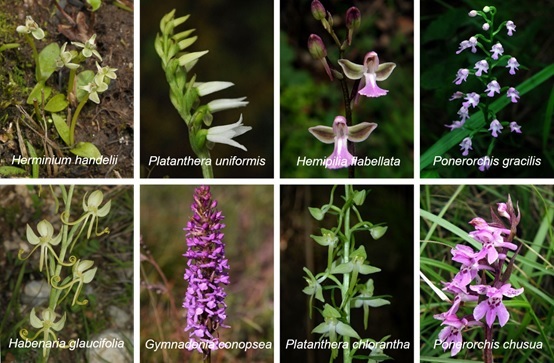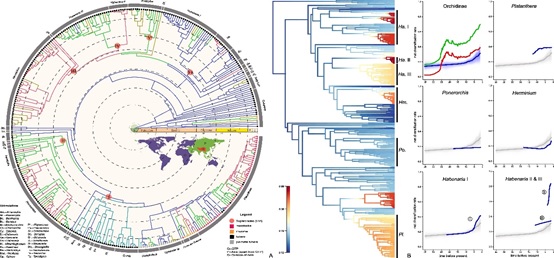The Qinghai-Tibetan Plateau s.l. (QTP), including the Himalaya, Tibetan Plateau, and Hengduan Mountains, is the highest and most extensive plateau in the world. The QTP is noteworthy for its extraordinary species richness, geographical and ecological heterogeneity, and complex history of the plateau uplift. It has over 12,000 species (ca. 1500 genera) of vascular plants, within the tropical seasonal forest to alpine meadows.
Scientists from the Institute of Botany of the Chinese Academy of Sciences (IBCAS), together with domestic and international collaborators, explored the origins of the extraordinary plant diversity in the Qinghai-Tibet Plateau, based on global sampling and multiple analysis by using Orchidinae (Orchidaceae) as a proxy, which is the most species-rich orchid clade in the QTP.
“The QTP is an ideal natural laboratory for the study of the biodiversity and evolution of biology”, said Dr. Yangjun Lai, first author of this study from IBCAS.
The findings indicate that six major clades in Orchidinae exhibited substantial variation in the temporal and spatial sequence of diversification. The species-richness of Orchidinae arose through a combination of in situ diversification, colonisation, and local recruitment. There are multiple origins of species-richness of Orchidinae in the QTP, and pre-adaptations in clades from North Temperate and alpine regions were crucial for in situ diversification.
The geographic analysis identified 29 dispersals from Asia, Africa and Europe into the QTP and 15 dispersals out. Most endemic species of Orchidinae evolved within the past six million years.
The study was published in Molecular Phylogenetics and Evolution, entitled "Diversification in Qinghai-Tibet Plateau: Orchidinae (Orchidaceae) clades exhibiting pre-adaptations play critical role".

The representative species of Orchidinae from the QTP (By IBCAS)

Chronogram and ancestral area reconstruction of biogeographical patterns in QTP Orchidinae, and the Net diversification rates over time among Orchidinae clades
Article Link: https://www.sciencedirect.com/science/article/pii/S1055790320303341
Contact: 010-62836085
Email: xiaohua@ibcas.ac.cn
Institute of Botany, Chinese Academy of Sciences
The Qinghai-Tibetan Plateau s.l. (QTP), including the Himalaya, Tibetan Plateau, and Hengduan Mountains, is the highest and most extensive plateau in the world. The QTP is noteworthy for its extraordinary species richness, geographical and ecological heterogeneity, and complex history of the plateau uplift. It has over 12,000 species (ca. 1500 genera) of vascular plants, within the tropical seasonal forest to alpine meadows.
Scientists from the Institute of Botany of the Chinese Academy of Sciences (IBCAS), together with domestic and international collaborators, explored the origins of the extraordinary plant diversity in the Qinghai-Tibet Plateau, based on global sampling and multiple analysis by using Orchidinae (Orchidaceae) as a proxy, which is the most species-rich orchid clade in the QTP.
“The QTP is an ideal natural laboratory for the study of the biodiversity and evolution of biology”, said Dr. Yangjun Lai, first author of this study from IBCAS.
The findings indicate that six major clades in Orchidinae exhibited substantial variation in the temporal and spatial sequence of diversification. The species-richness of Orchidinae arose through a combination of in situ diversification, colonisation, and local recruitment. There are multiple origins of species-richness of Orchidinae in the QTP, and pre-adaptations in clades from North Temperate and alpine regions were crucial for in situ diversification.
The geographic analysis identified 29 dispersals from Asia, Africa and Europe into the QTP and 15 dispersals out. Most endemic species of Orchidinae evolved within the past six million years.
The study was published in Molecular Phylogenetics and Evolution, entitled "Diversification in Qinghai-Tibet Plateau: Orchidinae (Orchidaceae) clades exhibiting pre-adaptations play critical role".

The representative species of Orchidinae from the QTP (By IBCAS)

Chronogram and ancestral area reconstruction of biogeographical patterns in QTP Orchidinae, and the Net diversification rates over time among Orchidinae clades
Article Link: https://www.sciencedirect.com/science/article/pii/S1055790320303341
Contact: 010-62836085
Email: xiaohua@ibcas.ac.cn
Institute of Botany, Chinese Academy of Sciences
